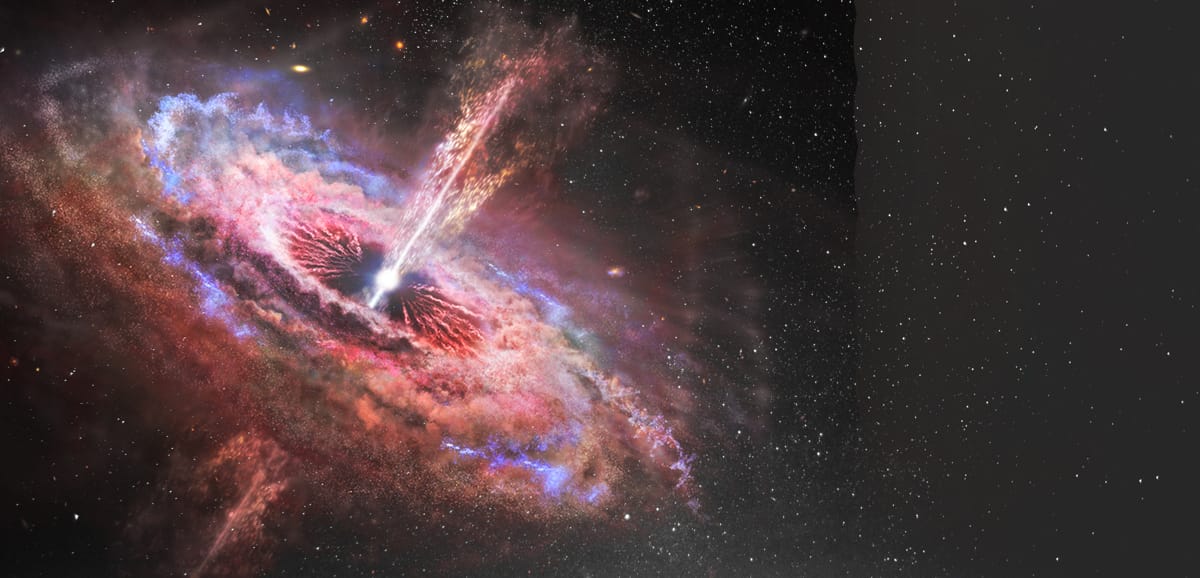
The TESS-Keck Survey. XVIII. A Sub-Neptune and Spurious Long-period Signal in the TOI-1751 System
Desai, Anmol; Turtelboom, Emma V.; Harada, Caleb K.; Dressing, Courtney D.; Rice, David R.; et al.
https://ui.adsabs.harvard.edu/abs/2024AJ....167..194D/abstract
https://iopscience.iop.org/article/10.3847/1538-3881/ad29ee
We present and confirm TOI-1751 b, a transiting sub-Neptune orbiting a slightly evolved, solar-type, metal-poor star (T eff = 5996 ± 110 K, log(g)=4.2±0.1 , V = 9.3 mag, [Fe/H] = ‑0.40 ± 0.06 dex) every 37.47 days. We use TESS photometry to measure a planet radius of 2.77+0.15−0.07 R⊕ . We also use both Keck/HIRES and APF/Levy radial velocities (RV) to derive a planet mass of 14.5+3.15−3.14M⊕ , and thus a planet density of 3.6 ± 0.9 g cm‑3. There is also a long-period (∼400 days) signal that is observed in only the Keck/HIRES data. We conclude that this long-period signal is not planetary in nature and is likely due to the window function of the Keck/HIRES observations. This highlights the role of complementary observations from multiple observatories to identify and exclude aliases in RV data. Finally, we investigate the potential compositions of this planet with the MAGRATHEA planet interior model, including rocky and water-rich solutions, as well as theoretical irradiated ocean models. TOI-1751 b is a warm sub-Neptune with an equilibrium temperature of ∼820 K. As TOI-1751 is a metal-poor star, TOI-1751 b may have formed in a water-enriched formation environment. We thus favor a volatile-rich interior composition for this planet.
 A comparison of TOI-1751’s size to Earth with one possible interior structure represented by a 3D model. This interior has a large atmosphere of H/He and a supercritical water layer on top of a rocky mantle and iron core compared to the Earth which only has rock and iron.
A comparison of TOI-1751’s size to Earth with one possible interior structure represented by a 3D model. This interior has a large atmosphere of H/He and a supercritical water layer on top of a rocky mantle and iron core compared to the Earth which only has rock and iron.
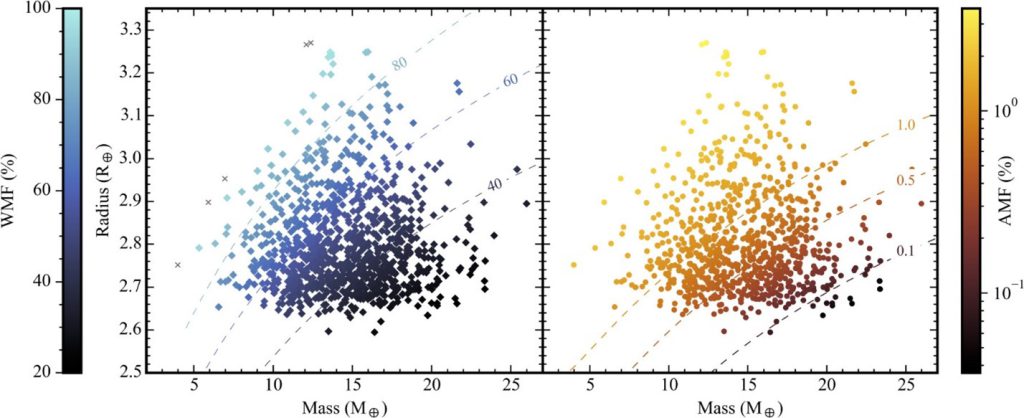 Mass vs. radius posterior samples from the joint transit and RV fit for TOI-1751 b modeled with MAGRATHEA. Left: Models of TOI-1751 b assuming an Earth-like rock/iron ratio, no atmosphere (i.e., AMF = 0%), a supercritical and condensed water layer, and a water envelope. By allowing the planet’s envelope to be made of water, the WMF required to reproduce the planet’s radius is substantially reduced. Grey x’s mark mass and radius samples which are too low density to be modeled with AMF=0%. Right: Models of TOI-1751 b assuming an Earth-like mantle/core ratio, a WMF of 20%, and a non-ideal H/He atmosphere. The non-ideal atmosphere is less compressible than an ideal H/He envelope, and thus a smaller AMF is needed to reproduce the measured planet radius. Iso-composition curves for WMF and AMF are shown with dashed lines.
Mass vs. radius posterior samples from the joint transit and RV fit for TOI-1751 b modeled with MAGRATHEA. Left: Models of TOI-1751 b assuming an Earth-like rock/iron ratio, no atmosphere (i.e., AMF = 0%), a supercritical and condensed water layer, and a water envelope. By allowing the planet’s envelope to be made of water, the WMF required to reproduce the planet’s radius is substantially reduced. Grey x’s mark mass and radius samples which are too low density to be modeled with AMF=0%. Right: Models of TOI-1751 b assuming an Earth-like mantle/core ratio, a WMF of 20%, and a non-ideal H/He atmosphere. The non-ideal atmosphere is less compressible than an ideal H/He envelope, and thus a smaller AMF is needed to reproduce the measured planet radius. Iso-composition curves for WMF and AMF are shown with dashed lines.
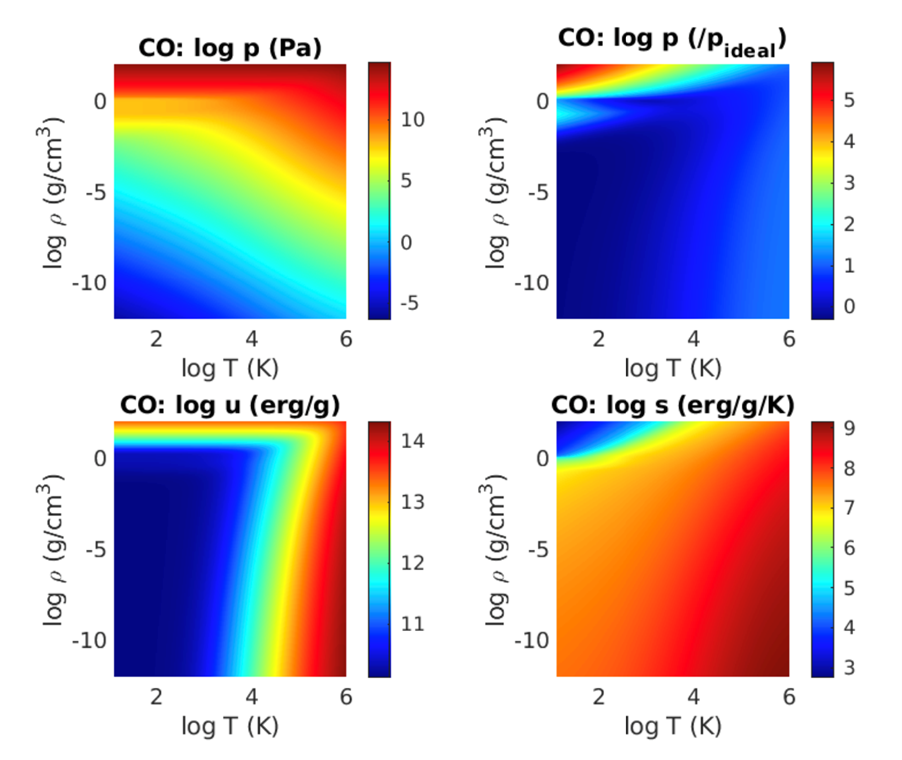
An equation of state of CO for use in planetary modeling
Podolak, Levi, Vazan, Malamud 2023
https://ui.adsabs.harvard.edu/abs/2023Icar..39415424P/abstract
Although carbon monoxide (CO) is an abundant molecule and may have great importance for planetary interiors, measurements of its properties are difficult due to its extreme volatility. We calculate the equation of state for CO over a range of temperature and density that is applicable to the conditions in planetary interiors. Previous experimental and theoretical studies cover only a limited temperature-density range. Our calculations match these early results well, but now cover the full range of relevance. The method of calculation is based on the general-purpose quotidian equation of state described by More et al. (1988), which is here used in order to generate a freely downloadable look-up table to be used by the community.
 Thermodynamic properties of CO as a function of density and temperature as computed from the quotidian equation of state. Upper left: total pressure. Upper right: pressure divided by ideal gas pressure. This shows the region where an ideal gas approximation may be used. Lower left: specific internal energy. Lower right: specific entropy.
Thermodynamic properties of CO as a function of density and temperature as computed from the quotidian equation of state. Upper left: total pressure. Upper right: pressure divided by ideal gas pressure. This shows the region where an ideal gas approximation may be used. Lower left: specific internal energy. Lower right: specific entropy.

How planets form by pebble accretion V. Silicate rainout delays contraction of sub-Neptunes
Vazan, Ormel, Brouwers 2024 – A&A
https://ui.adsabs.harvard.edu/abs/2024arXiv240509900V/abstract
The characterization of Super-Earth-to-Neptune sized exoplanets relies heavily on our understanding of their formation and evolution. In this study, we link a model of planet formation by pebble accretion (Ormel et al. 2021) to the planets' long-term observational properties by calculating the interior evolution, starting from the dissipation of the protoplanetary disk. We investigate the evolution of the interior structure in 5-20 Earth mass planets, accounting for silicate redistribution caused by convective mixing, rainout (condensation and settling), and mass loss. Specifically, we have followed the fate of the hot silicate vapor that remained in the planet's envelope after planet formation, as the planet cools. We find that disk dissipation is followed by a rapid contraction of the envelope from the Hill/Bondi radius to about one-tenth of that size within 10 Myr. Subsequent cooling leads to substantial growth of the planetary core through silicate rainout, accompanied by inflated radii, in comparison to the standard models of planets that formed with core-envelope structure. We examine the dependence of rainout on the planet's envelope mass, distance from its host star, its silicate mass, and the atmospheric opacity.
We find that the population of planets formed with polluted envelopes can be roughly divided in three groups, based on the mass of their gas envelopes: bare rocky cores that have shed their envelopes, super-Earth planets with a core-envelope structure, and Neptune-like planets with diluted cores that undergo gradual rainout. For polluted planets formed with envelope masses below 0.4 Earth mass, we anticipate that the inflation of the planet's radius caused by rainout will enhance mass loss by a factor of 2-8 compared to planets with non-polluted envelopes. Our model provides an explanation for bridging the gap between the predicted composition gradients in massive planets and the core-envelope structure in smaller planets.
 Summary sketch: interior evolution (x-axis) for different planetary masses (y-axis) formed with polluted envelopes. Planets can be classified into three groups regarding their interior structure: planets with massive gas envelopes that maintain part/all of their composition gradients, planets with low-mass envelopes that completed their rainout and have core-envelope structure, and planets that lost all of their gas (not shown).
Summary sketch: interior evolution (x-axis) for different planetary masses (y-axis) formed with polluted envelopes. Planets can be classified into three groups regarding their interior structure: planets with massive gas envelopes that maintain part/all of their composition gradients, planets with low-mass envelopes that completed their rainout and have core-envelope structure, and planets that lost all of their gas (not shown).

The metal-poor atmosphere of a Neptune/Sub-Neptune planet progenitor / Barat, Desert, Vazan et al. 2024 Nature astronomy
https://ui.adsabs.harvard.edu/abs/2024NatAs.tmp...86B/abstract
In this work we modelled the interior structure and thermal evolution of a newborn planet V1298 Tau b, orbiting a 23 million years star V1298 Tau.
Young transiting exoplanets offer a unique opportunity to characterize the atmospheres of fresh and evolving products of planet formation. We present the transmission spectrum of V1298 Tau b; a 23 Myr old warm Jovian sized planet orbiting a pre-main sequence star. We detect a primordial atmosphere with an exceptionally large atmospheric scale height and a water vapour absorption at 5σ level of significance. We estimate a mass and density upper limit (24±5M⊕, 0.12 g/cc respectively). V1298 Tau b is one of the lowest density planets discovered till date. We retrieve a low atmospheric metallicity (logZ=−0.10 solar), consistent with solar/sub-solar values. Our findings challenge the expected mass-metallicity from core-accretion theory. Our observations can be explained by in-situ formation via pebble accretion together with ongoing evolutionary mechanisms. We do not detect methane, which hints towards a hotter than expected interior from just the formation entropy of this planet. Our observations suggest that V1298 Tau b is likely to evolve into a Neptune/sub-Neptune type of planet.
 Left: Evolution of radius (upper panel) and internal temperature (lower panel) of two possible formation-evolution tracks; core-envelope structure (black line) and diluted core structure (red line) of V1298 Tau b. Solid and dotted lines represent simulations with sub-solar (0.1 solar) and solar envelope metallicity. Right: the metal distribution in the interior as a function of pressure for the two models at its current age (23 Myr). Models are calculated for in-situ formation of planets with 35-45% H/He (in mass), starting from Hill sphere radius.
Left: Evolution of radius (upper panel) and internal temperature (lower panel) of two possible formation-evolution tracks; core-envelope structure (black line) and diluted core structure (red line) of V1298 Tau b. Solid and dotted lines represent simulations with sub-solar (0.1 solar) and solar envelope metallicity. Right: the metal distribution in the interior as a function of pressure for the two models at its current age (23 Myr). Models are calculated for in-situ formation of planets with 35-45% H/He (in mass), starting from Hill sphere radius.
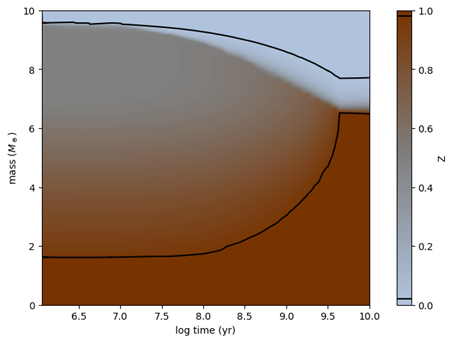
Rocky sub-Neptunes formed by pebble accretion: Rain of rock from polluted envelopes
Allona Vazan & Chris W. Ormel
Sub-Neptune planets formed in the protoplanetary disk accreted hydrogen-helium (H,He) envelopes. Planet formation models of sub-Neptunes formed by pebble accretion result in small rocky cores surrounded by polluted H,He envelopes, where most of the rock (silicate) is in vapor form at the end of the formation phase. This vapor is expected to condense and rain out as the planet cools. In this letter, we examine the timescale for the rainout and its e ect on the thermal evolution. We calculate the thermal and structural evolution of a 10 Earth masses planet formed by pebble accretion, considering material redistribution from silicate rainout (condensation and settling) and from convective mixing. We find that the duration of the rainout in sub-Neptunes is on an Gyr timescale and varies with envelope mass: planets with envelopes below 0.75 Earth mass rain out into a core-envelope structure in less than 1 Gyr, while planets in excess of 0.75 Earth mass of H,He preserve some of their envelope pollution for billions of years. The energy released by the rainout inflates the radius with respect to planets that start out from a plain core-envelope structure. This inflation would result in estimates of the H,He contents of observed exoplanets based on the standard core-envelope structure to be too high. We identify a number of planets in the exoplanet census where rainout processes may be at work, plausibly resulting in their H,He contents to be overestimated by up to a factor two. Future accurate age measurements by the PLATO mission may allow for the identification of planets formed with polluted envelopes.
Link to the publication in A&A Letters:
https://www.aanda.org/articles/aa/pdf/2023/08/aa46574-23.pdf
 Silicate mass fraction (color) as a function of interior layers (y axis) and time (x axis). Silicate mass fraction ranges between zero (gas only) in blue and pure silicate in brown. The gradual distribution of silicate from formation converges into a core-envelope structure after about 4.25 Gyr. The solid lines signify Z = 0:98 and Z = 0:02 enrichment levels. Versions of this figure for radius and pressure layers instead of mass are presented in the letter in Appendix B.
Silicate mass fraction (color) as a function of interior layers (y axis) and time (x axis). Silicate mass fraction ranges between zero (gas only) in blue and pure silicate in brown. The gradual distribution of silicate from formation converges into a core-envelope structure after about 4.25 Gyr. The solid lines signify Z = 0:98 and Z = 0:02 enrichment levels. Versions of this figure for radius and pressure layers instead of mass are presented in the letter in Appendix B.
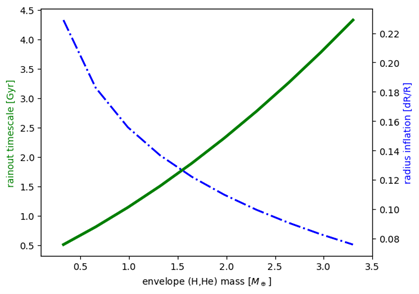 Time from formation until convergence to a core-envelope structure (rainout timescale) as a function of envelope mass, shown in green. Trend is shown for sub-Neptune planets that contain 6.7 Earth masses of silicates and their gas (H,He) mass is determined by the mass loss rate, from 3.3 Earth masses down to 0.33 Earth masses. In blue, we show the maximum radius inflation by rainout in comparison to the core-envelope structure model at the rainout timescale. Curves are polynomial fits for the evolution data points.
Time from formation until convergence to a core-envelope structure (rainout timescale) as a function of envelope mass, shown in green. Trend is shown for sub-Neptune planets that contain 6.7 Earth masses of silicates and their gas (H,He) mass is determined by the mass loss rate, from 3.3 Earth masses down to 0.33 Earth masses. In blue, we show the maximum radius inflation by rainout in comparison to the core-envelope structure model at the rainout timescale. Curves are polynomial fits for the evolution data points.

Interiors of ice-rich planets: mixed ice and rock
Although water is necessary for life as we know it, a large fraction of water in exoplanet interiors may lead to unique conditions, under which the interior structure differs from the simple layered structure of a water ocean on top of a rocky surface, that supports life. In this work we use experimental data of ice-rock interaction at high pressure, and calculate detailed thermal evolution for possible interior configurations of ice-rich planets, in the mass range of super-Earth to Neptunes (5-15 Earth masses). We model the effect of migration inward on the ice-rich interior by including the influences of stellar flux and envelope mass loss.
Our main findings are:
- Ice (water) and rock are expected to remain mixed, due to miscibility at high pressure, in substantial parts of the interiors of ice-rich planet in the mass range of 5-15 Earth masses, even after Gyrs of thermal evolution.
- Effect of migration on the thermal evolution of the deep interior is small. The deep interior of planetary twins that have migrated to different distances from the star (beyond 0.03AU) are similar, if mass loss is insignificant.
- Significant mass loss results in separation of the water from the rock on the surface and emergence of a volatile atmosphere of less than 1% of the planet's mass. In the absence of hydrogen-helium envelope the ice and rock demix at the surface (at distances larger than 0.02AU). The rock is then dissolved in the deeper layers where ice and rock remain mixed, and the outer envelope is composed of water in steam / condensed form.
- The mass of the atmosphere of water / steam is limited by the ice-rock interaction. The total ice / water content of a planet cannot be inferred from the atmospheric mass and abundance, as large fraction of the ice may be stored in the interior, mixed with the rock.
- Mixing of elements by convection (convective-mixing) is limited in ice-rich planets. The gradual structure is mostly stable along the thermal evolution. Planets with gradual metal distribution have hotter deep interiors, in comparison to core-envelope structure.
- Ice-rich planets with substantial gas envelopes develop ice-rock demixing only in the outer gas envelope, where water is miscible in the hydrogen.
- Mass loss increases the metal enrichment of the envelope. For planets with gradual composition distribution the mass loss flattens the composition gradient, resulting in large scale convection and fast cooling.
A new perspective on interiors of ice-rich planets: Ice-rock mixture instead of ice on top of rock / Vazan, Allona; Sari Re’em; Kessel RonitArxiv version Journal version Pubic summary
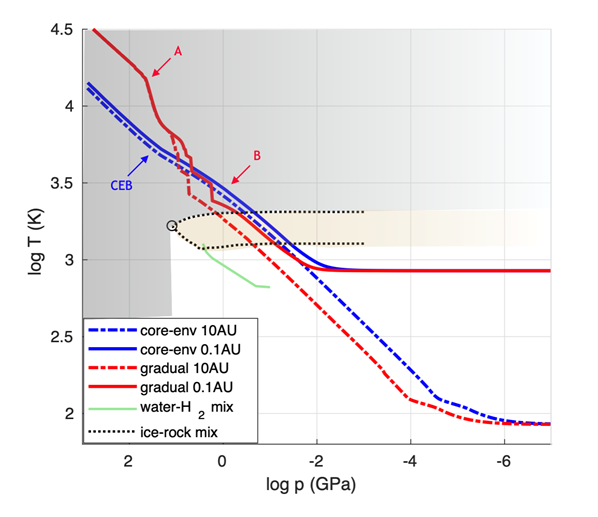 Pressure-temperature profiles of 15 Earth mass planets with 10% gas at the age of 10 Gyr. The same metal (ice and rock) content is gradually distributed (red) or located in a pure metal core surrounded by a gas envelope (blue). Core-envelope boundary is marked with blue CEB arrow, and the gradual composition distribution region expands between the red A-B arrows. The planets are located at 10AU (dashed) or migrated to 0.1AU (solid). In the shaded areas, taken from Fig. 2, ice and rock are expected to stay mixed. Above the hydrogen-water mix curve (green), water is miscible in hydrogen. The mass in the shaded area is > 99% of the planet’s mass for all cases.
Pressure-temperature profiles of 15 Earth mass planets with 10% gas at the age of 10 Gyr. The same metal (ice and rock) content is gradually distributed (red) or located in a pure metal core surrounded by a gas envelope (blue). Core-envelope boundary is marked with blue CEB arrow, and the gradual composition distribution region expands between the red A-B arrows. The planets are located at 10AU (dashed) or migrated to 0.1AU (solid). In the shaded areas, taken from Fig. 2, ice and rock are expected to stay mixed. Above the hydrogen-water mix curve (green), water is miscible in hydrogen. The mass in the shaded area is > 99% of the planet’s mass for all cases.
 Schematic interior structure of ice-rich planets for different mass loss scenarios: no mass loss (left), hydrogen mass loss (middle), all gas mass loss (right). Each sketch is split to show the two interior structures we examined. The ice & rock mixture region covers more than 99% of the planet's mass for planets in the mass range of 5M⊕ to 15M⊕ (and above).
Schematic interior structure of ice-rich planets for different mass loss scenarios: no mass loss (left), hydrogen mass loss (middle), all gas mass loss (right). Each sketch is split to show the two interior structures we examined. The ice & rock mixture region covers more than 99% of the planet's mass for planets in the mass range of 5M⊕ to 15M⊕ (and above).

Explaining the low luminosity of Uranus – interior evolution model
The low luminosity of Uranus is a long-standing challenge in planetary science. Simple adiabatic models are inconsistent with the measured luminosity, which indicates that Uranus is non-adiabatic because it has thermal boundary layers and/or conductive regions. A gradual composition distribution acts as a thermal boundary to suppress convection and slow down the internal cooling. Here we investigate whether composition gradients in the deep interior of Uranus can explain its low luminosity, the required composition gradient, and whether it is stable for convective mixing on a timescale of some billion years. We varied the primordial composition distribution and the initial energy budget of the planet, and chose the models that fit the currently measured properties (radius, luminosity, and moment of inertia) of Uranus. We present several alternative non-adiabatic internal structures that fit the Uranus measurements.
Our main findings:
- A composition gradient in the interior of Uranus is stable and naturally explains Uranus low luminosity, without the need of artificial thermal boundaries. There are different types of composition gradients that are stable during the evolution and are sufficient to slow down the cooling and fit the observed radius, moment of inertia, and luminosity.
- The stable composition gradient suppresses convection and slows the interior cooling. As a result, the interior of Uranus might still be very hot, in spite of its low luminosity.
- The initial energy content of Uranus cannot be greater than 20% of its formation (solid accretion) energy. Primordial models with higher energy fail to fit the observations.
- Two- and three-layer models of Uranus are able to fit Uranus properties only if the interior is very cold and (partially) conductive. Therefore Uranus is probably non-adiabatic, and cannot be modelled by a simple large-scale convection model. The effect of the non-adiabatic cooling of Uranus (by composition gradient) on its current radius is 5–10%.
- The total heavy-element mass fraction in Uranus is affected by the non-adiabatic evolution. The hot gradual models are more metal rich (up to 95%) than the cold models (∼85%).
- Our models are consistent with its metal-rich atmosphere and with the predictions for the location where its magnetic field is generated.
Explaining the low luminosity of Uranus: a self-consistent thermal and structural evolution / Vazan, Allona; Helled RavitPublisher ArXiv version
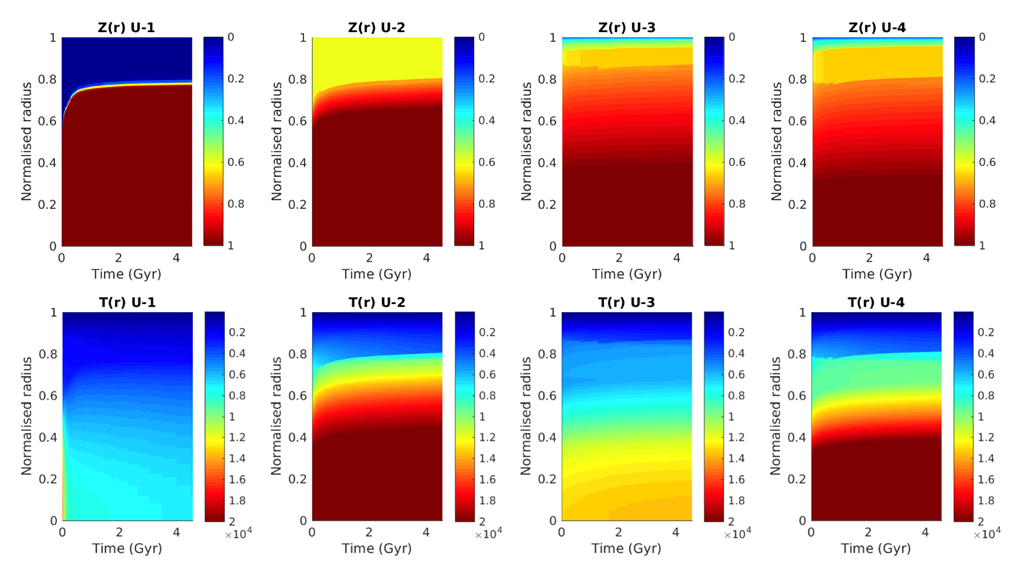 Thermal and structural evolution of Uranus (color) as a function of the radius layer (y-axis) and age (x-axis). Upper panel: heavy-element mass fraction. Bottom panel: temperature profile. The four cases are of valid Uranus models of different types: distinct layers (left), steep gradient (second), shallow gradient (third), and metal-rich shallow gradient (right).
Thermal and structural evolution of Uranus (color) as a function of the radius layer (y-axis) and age (x-axis). Upper panel: heavy-element mass fraction. Bottom panel: temperature profile. The four cases are of valid Uranus models of different types: distinct layers (left), steep gradient (second), shallow gradient (third), and metal-rich shallow gradient (right).
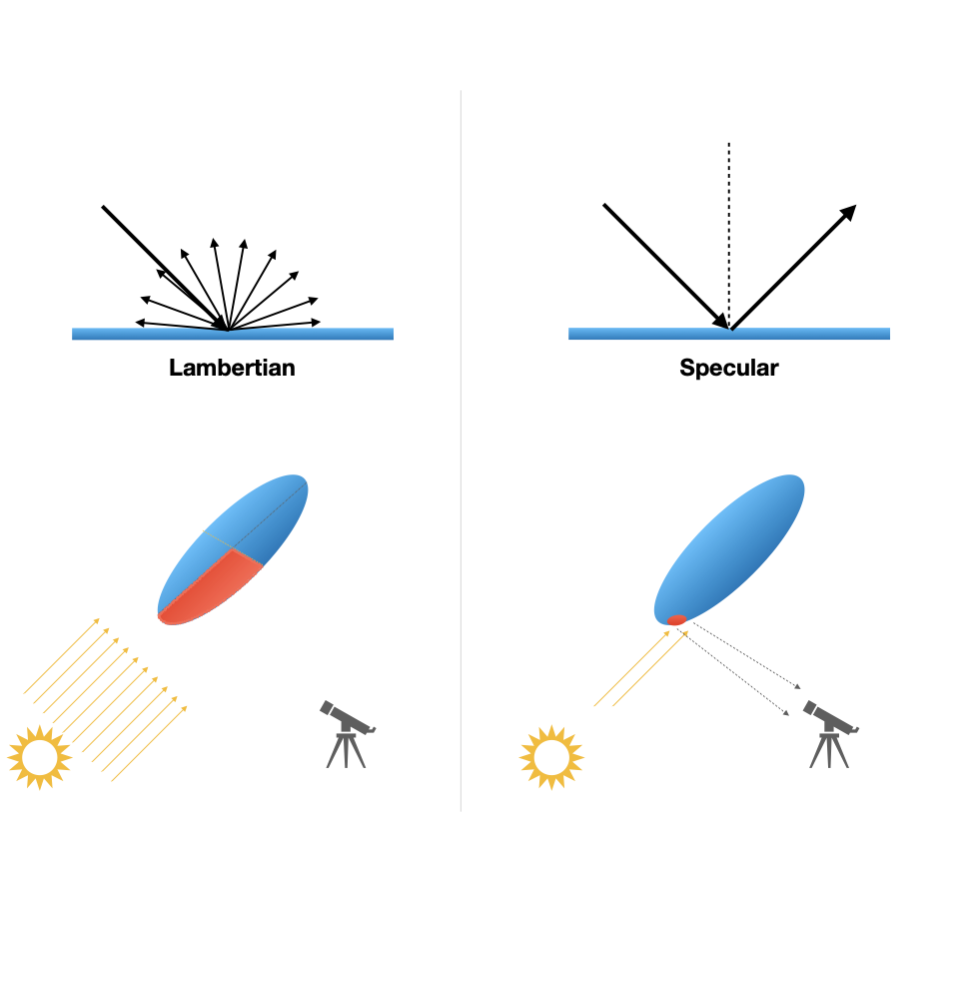
On the aspect ratio of ‘Omuamua – surface properties matter
As a first observed interstellar object, ’Oumuamua introduced new challenges to small bodies theories. Some of the challenges are related to the irregular elongated shape that is derived from its lightcurve ratio. The large brightness variation in the observed lightcurve of ’Oumuamua is probably related to its shape, i.e., to the ratio between its longest axis and its shortest axis (aspect ratio). Several approaches found the aspect ratio of ’Oumuamua to be unusually elongated. Moreover, the spin axis orientation has to be almost perpendicular to the observer in order to obtain such an extreme lightcurve, a configuration which is unlikely. However, interstellar ’Oumuamua may have different surface properties than we know in our solar system. Therefore, in this work we widen the parameter space for surface properties beyond the asteroid-like models and study its effect on ’Oumuamua’s lightcurve. We calculate reflection from a rotating ellipsoidal object for four models: Lambertian reflection, specular reflection, single scattering diffusive and backscatter . We then calculate the probability to obtain a lightcurve ratio larger than the observed, as a function of the object’s aspect ratio, assuming an isotopic spin orientation distribution. We find the elongation of ’Oumuamua to be less extreme for the Lambertian and specular reflection models. Consequently, the probability to observe the lightcurve ratio of ’Oumuamua given its unknown spin axis orientation is larger for those models. We conclude that different surface reflection properties may suggest alternatives to the extreme shape of ’Oumuamua, relieving the need for complicated formation scenario, extreme albedo variation, or unnatural origin. Although the models suggested in this work are for ideal ellipsoidal shape and ideal reflection method, the results emphasize the importance of surface properties for the derived aspect ratio.
On the aspect ratio of ’Oumuamua: less elongated shape for irregular surface properties / Vazan, Allona; Sari Re’emPublication in MNRAS ArXiv version
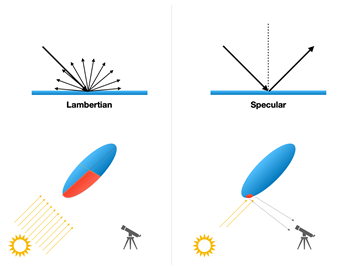 An illustration of Lambertian (left) and specular (right) reflection. Up: reflection from a plane unit surface area. Bottom: overall reflection from an ellipsoid. The surface area on each ellipsoid that contributes the observed brightness appears in red.
An illustration of Lambertian (left) and specular (right) reflection. Up: reflection from a plane unit surface area. Bottom: overall reflection from an ellipsoid. The surface area on each ellipsoid that contributes the observed brightness appears in red.
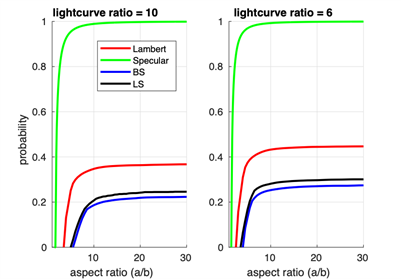 The probability to observe a lightcurve ratio of minimum 10 (left) and 6 (right) as a function of the object aspect ratio, for different surface reflection conditions: Lambertian (red), specular (green), backscatter (blue), and Lommel-Seeliger (black). For all cases phase angle is Θ = 24◦
The probability to observe a lightcurve ratio of minimum 10 (left) and 6 (right) as a function of the object aspect ratio, for different surface reflection conditions: Lambertian (red), specular (green), backscatter (blue), and Lommel-Seeliger (black). For all cases phase angle is Θ = 24◦
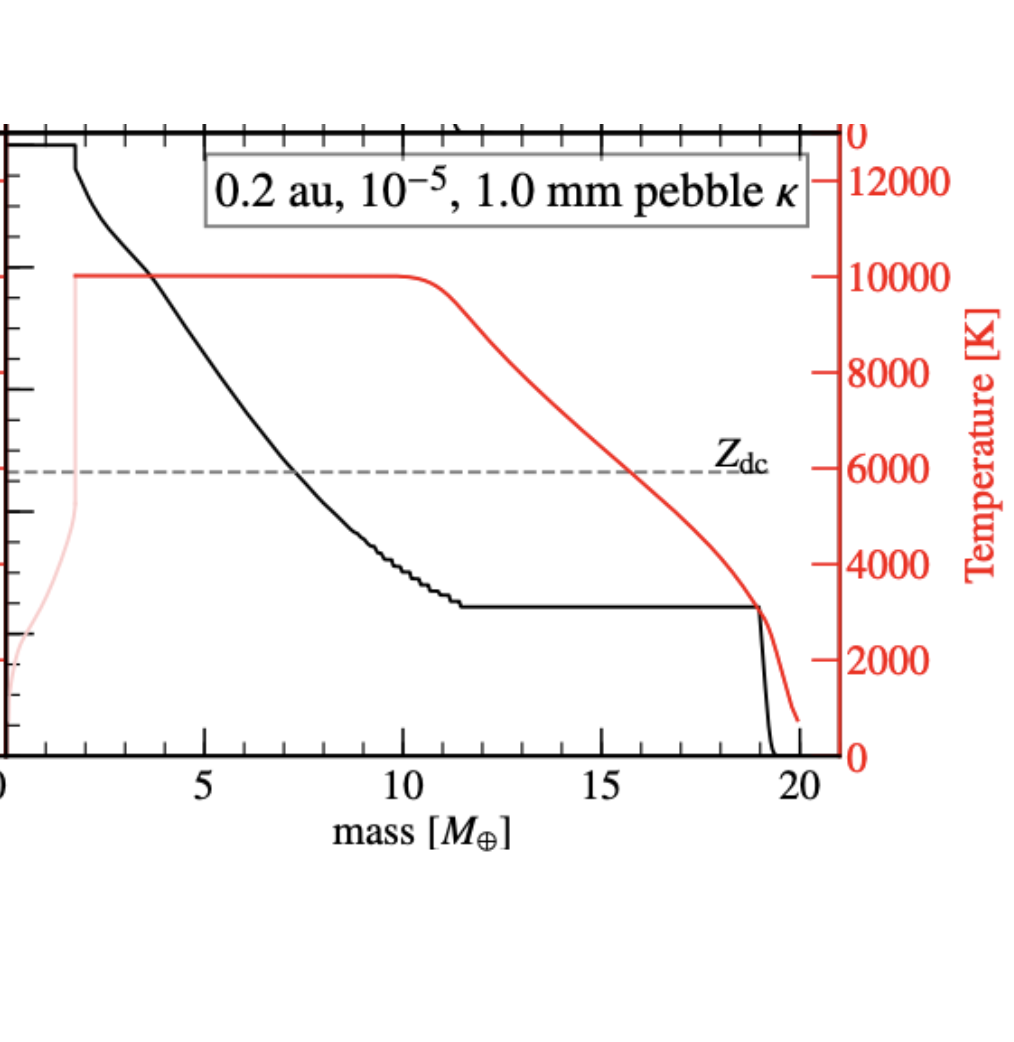
Planet formation by pebble accretion – emergence of composition gradient in the interior
In this work we compute planet formation by pebble accretion, focusing on deposition of accreted solids in the planetary interior. In this scenario, planets grow by the accretion of cm- to-m-sized pebbles instead of km-sized planetesimals. One of the main differences with planetesimal-driven core accretion is the increased thermal ablation experienced by pebbles. Small silicate, pebble-sized particles will sublimate in the atmosphere when they hit the sublimation temperature (T ∼ 2000 K). We conduct numerical calculations of the atmosphere of an accreting planet, solving the stellar structure equations, augmented by a non-ideal equation of state that describes a hydrogen/helium-silicate vapor mixture. We follow the energy and material deposition of the accreted solids (rocks and ices) to find the effect of it on the formation process and on the interior structure of the planet at the end of the formation phases. When pebbles sublimate before reaching the core, insufficient (accretion) energy is available to mix dense, vapor-rich lower layers with the higher layers of lower metallicity. A gradual structure in which Z decreases with radius is therefore a natural outcome of planet formation by pebble accretion. Such composition gradient is consistent with indications in the solar system gas giants Jupiter and Saturn by the Juno and Cassini spacecraft.
Our main findings are:
- The typical core mass that we find is around 1.5–2 M⊕. Further accretion enriches the gas envelope with metal vapors.
- The complete vaporization of pebbles naturally enriches the atmosphere in heavy elements. Based on elementary energy considerations, the dense, heavy metal layer may only partially mix with the H/He gas. Consequentially, a compositional gradient naturally forms.
- Temperature and metallicity profiles differ significantly between the ideal and non-ideal EoS runs.
- In the outer disk regions, where the molecular opacity is low, small pebbles dominate the opacity. When also the pebble accretion rate is high, atmospheres become very polluted. The crossover mass becomes large and its value independent of distance.
- When planets stop accreting pebbles, accretion of nebular gas will quickly take over as the atmospheres loose their opacity. Thus more viable mechanism is required to prevent sub-Neptunes from reaching runaway gas accretion.
How planets grow by pebble accretion. III. Emergence of an interior composition gradient / Ormel, Chris; Vazan, Allona; Brouwers, MarcPublication in A&A ArXiv version
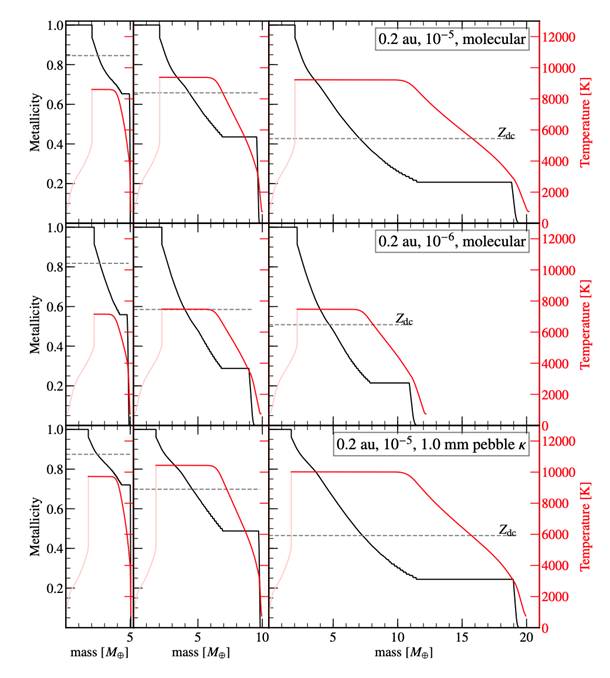 Metallicity and temperature profiles for several runs at 0.2 au: with an accretion rate of 10^−5 M⊕ per year (top); a lower accretion rate of 10−6 M⊕ per year (center); and a pebble opacity corresponding to mm-sized pebbles. Profiles are shown when M = 5, 10 and 20 M⊕ are reached (unless crossover is reached sooner). The temperature in the classical core region, which is not modelled, indicates the temperature at the core-envelope boundary when the material was incorporated.
Metallicity and temperature profiles for several runs at 0.2 au: with an accretion rate of 10^−5 M⊕ per year (top); a lower accretion rate of 10−6 M⊕ per year (center); and a pebble opacity corresponding to mm-sized pebbles. Profiles are shown when M = 5, 10 and 20 M⊕ are reached (unless crossover is reached sooner). The temperature in the classical core region, which is not modelled, indicates the temperature at the core-envelope boundary when the material was incorporated.


